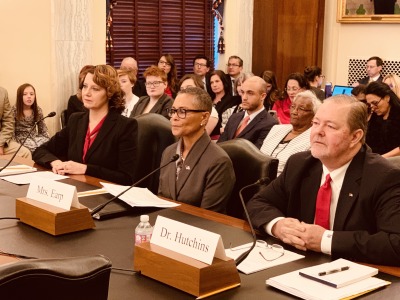Trade remains the top concern for American agriculture heading into 2020, with looming uncertainty about whether the Chinese will make promised increases in commodity purchases, and whether President Donald Trump will provide another round of trade assistance to U.S. producers.
But with a presidential election looming, the Trump administration is under the gun to roll out a series of major regulatory changes, including a new “waters of the U.S. rule" and a speedier approval process for biotech crops, that could have impacts on U.S. agriculture for years to come.
The list of regulatory measures due in 2020 that will affect the agriculture and food industry also includes two additional rules tightening eligibility for the Supplemental Nutrition Assistance Program.
Congress still has unfinished business heading into this year, including final approval of the U.S.-Mexico-Canada Agreement and a new biennial water projects authorization bill as well as the government’s annual spending bills. And farm groups are pressuring Congress to do something to alleviate growing farm labor costs.
But the window for Congress to get much done this year will close quickly as the campaign season heats up, starting with the Iowa presidential caucuses on Feb. 3.
Paul Schlegel, vice president of public affairs for the American Farm Bureau Federation, said the legislative process will likely slow as the field of Democratic presidential candidates narrows and lawmakers look toward November. “We would want to get stuff done sooner,” he said.
Meanwhile, USDA is expected to announce soon whether it will provide the third tranche of trade mitigation payments under the administration’s 2019 Market Facilitation Program. Then, the question is whether there will be a 2020 MFP. The administration has given no indication of when that decision could be made.

Paul Schlegel, AFBF
Here is a more detailed look at what’s ahead in Congress and the Trump administration this year:
REGULATORY FRONT
New WOTUS expected soon
A new rule replacing the Obama-era definition of what wetlands and streams fall under the jurisdiction of the Clean Water Act is widely expected to be finalized early this year.
The final WOTUS rule was sent to the White House Office of Management and Budget for review on Dec. 5. Administration officials have a meeting scheduled Feb. 6 with the American Chemistry Council to discuss the rule. But the rule’s release could come before that, said Scott Yager, environmental counsel for the National Cattlemen’s Beef Association. "All signs point to the new water rule being finalized this month. It’s possible that it takes longer and happens in February.”
Regardless of when it is released, there will certainly be continued court fights over the rule for years to come. Two lawsuits were filed late last year following the publication by EPA and the Army Corps of Engineers of a separate rule that repealed the 2015 rule issued by the Obama administration.
The repeal rule, which took effect Dec. 23, revived 1986 regulations that were in place before the 2015 rule was finalized.
Administration wants to speed gene edited crops to market
OMB also is reviewing a final USDA rule that would provide the first major update to federal regulations for biotechnology in more than three decades. The department has been struggling for years with how to streamline its regulatory process for biotech plants in order to accelerate the commercialization of gene-edited crop traits.
The rule proposed last year by the Animal and Plant Health Inspection Service was broadly criticized by industry interests. Biotech companies said it didn’t go far enough and would still slow the commercialization of many gene-edited products. But groups representing grain traders, food processors and restaurant chains have told USDA the changes could lead to trade disruptions and undermine consumer confidence.
EPA, meanwhile, sent a proposed rule to OMB last week to revise its regulations for crops that contain their own pesticides. Corn and cotton crops already are commonly engineered to contain a bacterium toxin known as Bt.
In a description of the rule, EPA said it would deal with “newer technologies” and exemptions from pesticide registration requirements. The rule also would provide tolerances or tolerance exemptions for residues in or on food commodities.
FDA proposing new produce water standards
The Food and Drug Administration is reworking regulations for water that is used to irrigate fruit and vegetable crops that are commonly eaten fresh. FDA officials said in a blog post Tuesday the proposed new standards would be released this year. FDA earlier delayed implementation of water regulations issued by the Obama administration under the Food Safety Modernization Act.
“FDA experts are now working on a rulemaking to propose an approach that offers flexibility and addresses the practical challenges of implementing some of the agricultural water requirements across the diversity in farm types, water sources, and water uses,” the officials wrote.
USDA presses ahead with SNAP cuts
Regulations that will make it harder for states to get waivers from SNAP work requirements for able-bodied adults will take effect in April. USDA is finalizing additional rules that will effectively lower income eligibility limits in many states and change the way that utility expenses are used to calculate SNAP benefits.
The most controversial of the additional proposals would rewrite categorical eligibility provisions that allow people to automatically receive SNAP benefits if they receive any benefits or services through the Temporary Assistance for Needy Families program. In many states, the service consists of as little as a brochure or hotline referral. The effect of the provisions is to allow families to qualify for SNAP with incomes up to twice the federal poverty line. Children in those households are also automatically eligible for free school lunches.
Some 36.3 million people received SNAP benefits in September, the latest month for which data is available. Enrollment has been falling steadily for several years as the economy has improved. Average annual enrollment peaked at 47.6 million in 2013.
CONGRESS
USMCA, water projects among congressional priorities
Work on the USMCA implementing bill should be wrapped up soon. The only question is when the final Senate vote will be. That depends on how soon House Speaker Nancy Pelosi sends impeachment articles to the Senate, because that issue will take precedence over the USMCA vote, said Senate Finance Committee Chairman Chuck Grassley, R-Iowa.
Meanwhile, there are several reauthorization bills in various stages of development, including legislation for child nutrition programs and the Commodity Futures Trading Commission. But those issues have languished for years, unlike water projects reauthorization, an issue that has had more bipartisan support in recent years.
Interested in more coverage and insights? Receive a free month of Agri-Pulse or Agri-Pulse West by clicking here.
A new two-year water projects bill is due to be passed by the end of the year to replace the 2018 measure. The top priority for agriculture interests is to change the way waterway projects are funded to accelerate replacement of existing locks and dams.
Under current law, inland waterway improvements must get half their funding from the Inland Waterways Trust Fund, the revenue of which comes from a 29-cent-per-gallon tax on barge fuel. The other half comes from the general treasury.
The Waterways Council, which represents shipping interests, and the American Soybean Association are asking Congress to require 75% of the funding to come from general revenues versus 25% from the IWTF. “If constrained to a 50-50 cost share, many of the IWTF projects will not even begin construction in the next 20 years,” the soybean association said in a letter to lawmakers last summer.
The House Transportation and Infrastructure Committee has a hearing on the reauthorization measure this week.

Three USDA nominees (L to R: Mindy Brashears, Naomi Earp and Scott Hutchins) await Senate confirmation.
Child nutrition, USDA nominees stalled in Senate
The Senate Agriculture Committee has plenty of unfinished business this year as Chairman Pat Roberts, R-Kan., prepares for his retirement. His to-do list includes a reauthorization of child nutrition programs, but he told Agri-Pulse this week there is still no agreement with the committee’s Democratic side on what should be in the legislation.
Meanwhile, Sen John Kennedy, R-La., continues to block final Senate votes on committee-approved USDA nominees over his concerns about how the Trump administration is handling ethanol policy.
Roberts said he has so far been unable to persuade Kennedy to release his hold on the nominees including Mindy Brashears, who was nominated to be undersecretary for food safety and Scott Hutchins, picked to be undersecretary for research, education and economics. Both are serving in acting deputy positions.
Even as those nominees remain stalled, the White House sent another nomination to the Senate this week, that of Brandon Lipps to be undersecretary for food, nutrition and consumer services. The nomination is likely to be particularly controversial because of the administration’s ongoing efforts, led by Lipps, to cut the cost and size of SNAP.
Senate Ag also could consider a House bill to expand the authority of the CFTC, but a bipartisan measure approved last fall by the House Agriculture Committee has not received a floor vote yet. The CFTC’s last reauthorization bill expired in 2013.
For more news go to www.Agri-Pulse.com.


